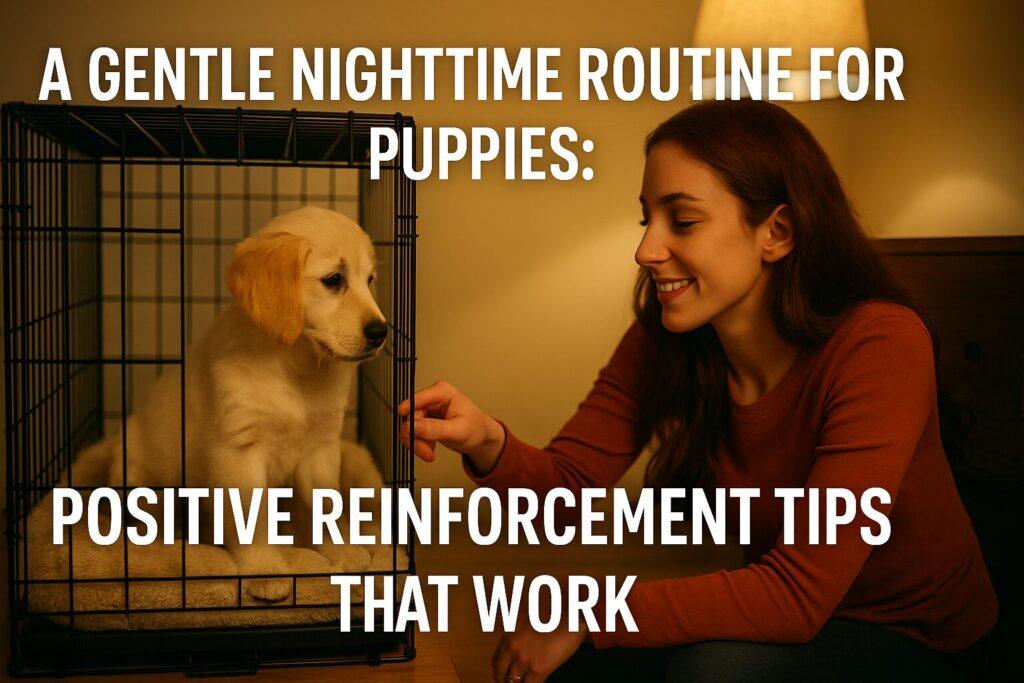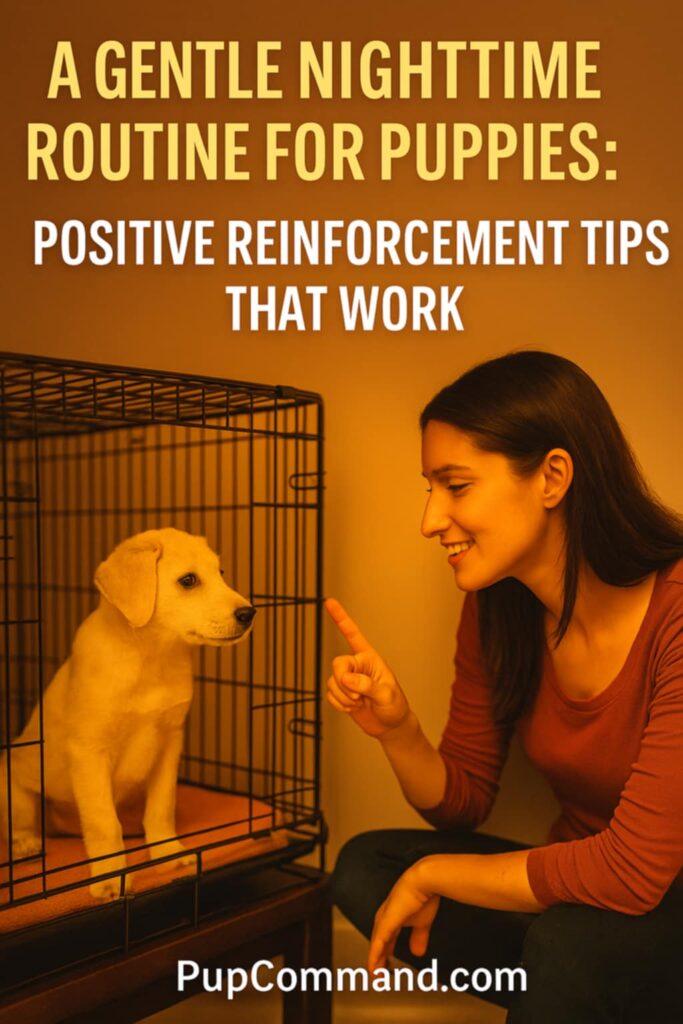
Nighttime can be one of the most overwhelming parts of puppyhood—for both new dogs and their humans. But it doesn’t have to be. Establishing a consistent, gentle bedtime routine rooted in positive reinforcement helps your puppy feel secure, encourages better sleep, and builds the kind of trust that lasts for life.
Establishing a gentle nighttime routine for puppies helps reduce anxiety, improve sleep, and build lasting trust—especially when guided by positive reinforcement.
In this article, we’ll walk through a proven nighttime routine designed specifically for puppies, using positive reinforcement to create a calm transition from day to night—no yelling, no punishment, and no guesswork.
Why a Gentle Nighttime Routine for Puppies Matters
Puppies are creatures of habit. Structure helps them feel safe, and a consistent nighttime rhythm is one of the fastest ways to reduce anxiety, whining, and nighttime accidents.
A gentle nighttime routine for puppies helps:
- Settle their nervous system before bed
- Understand when sleep is expected
- Learn where and how they’re supposed to sleep
- Strengthen emotional security and independence
Without a structured bedtime plan, many puppies struggle with crate resistance, vocalization, and interrupted sleep—all of which can affect their physical and behavioral development.
When to Start a Nighttime Routine
Start as early as possible—ideally the first night your puppy comes home. Even an 8-week-old puppy is ready to begin learning that nights are calm, predictable, and nothing to be afraid of.
Consistency is key. Whether your puppy is 9 weeks or 9 months old, the earlier you establish a bedtime flow, the faster they’ll adapt.
Step 1 of A Aentle Nighttime Routine for Puppies: Set the Stage for Sleep
About one hour before bedtime, begin transitioning your home from an active zone to a quiet environment.
What to Do:
- Turn off loud music or television
- Lower household lighting
- Encourage everyone in the home to speak more softly
- Begin winding down movement and interaction
This signals to your puppy’s brain that the day is ending. Dogs are sensitive to environmental cues, and subtle shifts in energy help them relax naturally.
Step 2: Gentle Play and Training
Before bed, puppies need one last chance to engage both mentally and physically. A light session of training or calm play helps them release pent-up energy without overstimulation.
Examples:
- 5–10 minutes of training (sit, down, touch) using treats
- Gentle tug games followed by a calm “settle” cue
- Short fetch sessions with a plush toy
- Hide-and-seek using treats or kibble
This isn’t the time for roughhousing. You want your puppy to be active enough to relax afterward, not revved up before sleep.
Step 3: Final Potty Break
Always take your puppy out for a final potty opportunity before putting them in their sleeping space. This reduces accidents and helps them sleep longer without interruption.
Tips:
- Use the same cue every night (“Go potty” or “Last chance”)
- Keep the outing calm and boring—no play or distractions
- Reward the behavior with quiet praise or a small treat
- Return straight indoors to keep the flow of bedtime predictable
Even if they don’t go, still give them the chance. Young puppies often need more than one try.

Step 4: Offer a Safe Chew or Kong
After their potty break and just before bedtime, offer your puppy a chewable comfort item. This satisfies their natural urge to chew and gives them something to do as they settle.
Ideal items include:
- A frozen stuffed Kong with soft puppy-safe ingredients
- A soft rubber teether
- A rolled-up towel with a bit of kibble hidden inside
- A vet-approved puppy chew
Chewing releases endorphins and helps reduce mild stress or separation anxiety.
Step 5: Guide Them Into Their Sleeping Space
Whether your puppy sleeps in a crate, playpen, or enclosed area, bedtime should be a smooth, predictable step—never abrupt or forceful.
Use a Cue:
Gently say your chosen phrase like:
“Bedtime, crate”
“Let’s go to sleep”
“Kennel up”
Toss a treat or toy inside and let your puppy enter voluntarily. If needed, guide them calmly by walking toward the crate, not chasing or lifting them in frustration.
What Not to Do:
- Don’t slam the door shut quickly
- Don’t give attention to whining right away
- Don’t linger nervously—this makes them think something is wrong
Your calm body language tells them that bedtime is safe and normal.
Step 6: Dim the Lights and Set the Environment
Once your puppy is settled, reduce environmental stimulation further.
✔ A gentle nighttime routine for puppies should include dim lighting, a consistent crate cue, and a calm final potty break.
Ideal nighttime cues include:
- Turning off or dimming nearby lights
- Playing soft white noise or a calming music playlist
- Covering part of the crate (if safe and breathable) to create a den-like atmosphere
- Staying visible in the room, if needed for reassurance
Puppies feel safer when the environment stays consistent and non-threatening.
Step 7: Handling Whining and Night Waking
It’s completely normal for young puppies to whine at night—especially during the first few weeks of crate or nighttime training.
The key is knowing when to intervene and when to wait.
If They Whine Immediately:
- Wait 30–60 seconds
- Respond with a calm, quiet phrase if needed
- Avoid eye contact or high-energy interaction
If They Wake Up After a Few Hours:
If you’re wondering when the crying will stop, don’t worry—a gentle nighttime routine for puppies can transform bedtime struggles into peaceful transitions.
- It may be a bathroom need
- Take them out with no talking, no play, no light
- Return them immediately to the crate afterward
If It’s Repetitive or Attention-Seeking:
- Do not reward with extra attention
- Make sure they’re getting enough stimulation during the day
- Reinforce calm behavior in the crate
Never scold your puppy for crying. It only builds fear and delays the learning process.
Most veterinary behaviorists agree: a gentle nighttime routine for puppies creates the emotional predictability they need to settle in safely.
What a Full Nighttime Routine Looks Like
Here’s how your evening might flow:
- 8:00 p.m. – Lights dimmed, TV off, family voices lowered
- 8:15 p.m. – Calm training and short play session
- 8:30 p.m. – Final potty break
- 8:45 p.m. – Gentle chew toy or Kong in the crate
- 8:50 p.m. – Cue your puppy into their sleeping space
- 8:55 p.m. – Turn on white noise and lights out
- 9:00 p.m. – Human leaves the room or lies nearby if needed
Consistency is more important than exact timing. Over time, your puppy will begin to anticipate this flow and fall asleep more easily.
Mistakes to Avoid
🚫 Skipping the wind-down
Jumping straight from play to bed can lead to overstimulation and whining.
🚫 Responding emotionally to whining
Your energy influences your puppy’s emotional state. Stay calm and predictable.
🚫 Changing sleeping locations every few nights
This disrupts routine. Keep their sleeping space consistent.
🚫 Using bedtime as a punishment
Never say “go to your crate” when your puppy misbehaves. That creates negative associations.
For more expert insight into how early routines and positive reinforcement shape a puppy’s lifelong behavior, read the American Veterinary Society of Animal Behavior’s official statement on puppy socialization. It’s a trusted, science-based resource every dog owner should see.
The Power of Positive Reinforcement at Night
Using praise, treats, toys, and timing effectively allows you to shape your puppy’s nighttime behavior without conflict. When working on building a gentle nighttime routine for puppies, positive reinforcement teaches your puppy that sleep is safe, expected, and even rewarding.
The result? Fewer accidents. Less whining. More rest for everyone in the home.
Your puppy isn’t just learning to sleep—they’re learning to trust. The most effective training happens when you combine structure with compassion.
A gentle nighttime routine for puppies is where that begins.
